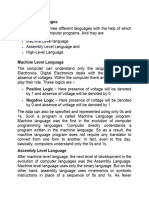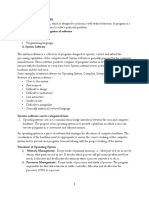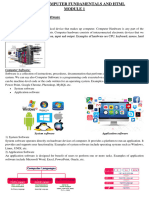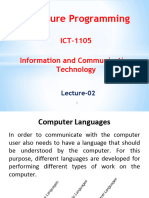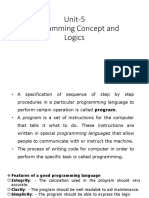Computer Software Definition
Uploaded by
mehulrawal64Computer Software Definition
Uploaded by
mehulrawal64Computer Software Definition :
Software is a generic term for organized collections of computer data and instructions, often broken into two major categories: system software that provides the basic non-task-specific functions of the computer, and application software which is used by users to accomplish specific tasks.
Types of Computer Software :
1 System Software 2 Application Software
System Software
System software is responsible for controlling, integrating, and managing the individual hardware components of a computer system so that other software and the users of the system see it as a functional unit without having to be concerned with the low-level details such as transferring data from memory to disk, or rendering text onto a display. Generally, system software consists of an operating system and some fundamental utilities such as disk formatters, file managers, display managers, text editors, user authentication (login) and management tools, and networking and device control software.
Application Software
Application software, on the other hand, is used to accomplish specific tasks other than just running the computer system. Application software may consist of a single program, such as an image viewer; a small collection of programs (often called a software package) that work closely together to accomplish a task, such as a spreadsheet or text processing system; a larger collection (often called a software suite) of related but independent programs and packages that have a common user interface or shared data format, such as Microsoft Office, which consists of closely integrated word processor, spreadsheet, database, etc.; or a software system, such as a database management system, which is a collection of fundamental programs that may provide some service to a variety of other independent applications.
Definition of Operating System :
An Operating System is a software program or set of programs that mediate access between physical devices (such as a keyboard, mouse, monitor, disk drive or network connection) and application programs (such as a word processor, WorldWide Web browser or electronic mail client).
Types of Operating Systems :
System 7.x Window 98 Window 2000 Linux Unix Xp
Popular Operating System's :
Unix : Multi-tasking, multi-processing, multi-user, protected, with built-in support for networking but not graphics. Window NT : Multi-tasking, multi-processing, single-user, protected, with built-in support for networking and graphics. Windows 95/98: Multi-tasking, multi-processing, single-user, unprotected, with builtin support for networking and graphics. Windows 3.x: Single-tasking, single-processing, single-user, unprotected, with built-in support for graphics but not networking. DOS: Single-tasking, single-processing, single-user, unprotected with no built-in support for graphics or networking. NetWare: Multi-tasking, multi-processing, single-user, unprotected, with built-in support for networking but not graphics.
Operating System 2 : This is another operating systems for powerful
microcomputers and networking. OS/2 was designed to avoid some of the most serious limitations of DOS. OS/2 runs in 4MB of memory, although it runs well in an 8MB system. It requires about 30MB of hard disk space.
Definition of Computer Language :
The term computer language includes a wide variety of languages used to communicate with computers. It is broader than the more commonly-used termprogramming language. Programming languages are a subset of computer languages. For example, HTML is a markup language and a computer language, but it is not traditionally considered a programming language. Machine code is a computer language. It can technically be used for programming, and has been (e.g. the original bootstrapper for Altair BASIC), though most would not consider it a programming language.
Types of Computer Languages :
1. Low Level Languages 2. High Level Languages
Low Level Languages :
Low level computer languages are machine codes or close to it. Computer cannot understand instructions given in high level languages or in English. It can only understand and execute instructions given in the form of machine language i.e. language of 0 and 1. There are two types of low level languages:
Machine Language. Assembly Language
Machine Language:
It is the lowest and most elementary level of Programming language and was the first type of programming language to be Developed. Machine Language is basically the only language which computer Can understand. In fact, a manufacturer designs a computer to obey just one Language, its machine code, which is represented inside the computer by a String of binary digits (bits) 0 and 1. The symbol 0 stands for the absence of Electric pulse and 1 for the presence of an electric pulse . Since a computer is Capable of recognizing electric signals, therefore, it understand machine Language. Advantages of Machine Language : i) It makes fast and efficient use of the computer. ii) It requires no translator to translate the code i.e.Directly understood by the computer.
Disadvantages of Machine Language : i) All operation codes have to be remembered. ii) All memory addresses have to be remembered. iii) It is hard to amend or find errors in a program written in the machine language. iv) These languages are machine dependent i.e. a particular.
Assembly Language :
It was developed to overcome some of the many inconveniences of machine language. This is another low level but a very important language in which operation codes and operands are given in the form of alphanumeric symbols instead of 0s and ls. These alphanumeric symbols will be known as mnemonic codes and can have maximum up to 5 letter combination e.g. ADD for addition, SUB for subtraction, START,LABEL etc. Because of this feature it is also known as Symbolic Programming Language. This language is also very difficult and needs a lot of practice to master it because very small English support is given to this language. The language mainly helps in compiler orientations. The instructions of the Assembly language will also be converted to machine codes by language translator to be executed by the computer. Advantages of Assembly Language : i) It is easier to understand and use as compared to machine language. ii) It is easy to locate and correct errors. iii) It is modified easily. Disadvantages of Assembly Language : i) Like machine language it is also machine dependent. ii) Since it is machine dependent therefore programmer Should have the knowledge of the hardware also.
High Level Languages
High level computer languages give formats close to English language and the purpose of developing high level languages is to enable people to write programs easily and in their own native language environment (English). High-level languages are basically symbolic languages that use English words and/or mathematical symbols rather than mnemonic codes. Each instruction in the high level language is translated into many machine language instructions thus showing one-to-many translation
Types of High Level Languages :
Many languages have been developed for achieving different variety of tasks, some are fairly specialized others are quite general purpose. These are categorized according to their use as
a) Algebraic Formula-Type Processing. These languages are oriented towards the
computational procedures for solving mathematical and statistical problem Examples are
BASIC (Beginners All Purpose Symbolic Instruction Code). FORTRAN (Formula Translation). PL/I (Programming Language, Version 1). ALGOL (Algorithmic Language). APL (A Programming Language).
These languages emphasize their capabilities for maintaining data processing procedures and files handling problems. Examples are:
b) Business Data Processing:
COBOL (Common Business Oriented Language). RPG (Report Program Generator
c) String and List Processing: These are used for string manipulation including search for
patterns, inserting and deleting characters. Examples are:
LISP (List Processing). Prolog (Program in Logic).
Object Oriented Programming Language
In OOP, the computer program is divided into objects. Examples are:
C++ Java
d) Visual programming language: these are designed for building Windows-based
applications Examples are:
Visual Basic Visual Java Visual C
Advantages of High Level Language :
Following are the advantages of a high level language:
User-friendly. Similar to English with vocabulary of words and symbols. Therefore it is easier to learn. They require less time to write. They are easier to maintain. Problem oriented rather than 'machine' based. Program written in a high-level language can be translated into many machine language and therefore can run on any computer for which there exists an appropriate translator. It is independent of the machine on which it is used i.e.Programs developed in high level language can be run on any Computer.
Disadvantages of High Level Language :
A high-level language has to be translated into the machine language by a translator and thus a price in computer time is paid. The object code generated by a translator might be inefficient Compared to an equivalent assembly language program.
You might also like
- Csc201: Introduction To Computer Programming I What Is A Computer?No ratings yetCsc201: Introduction To Computer Programming I What Is A Computer?12 pages
- C Programming: Department of Computer Science and EngineeringNo ratings yetC Programming: Department of Computer Science and Engineering310 pages
- Module 1 - Programming Basics and LogicNo ratings yetModule 1 - Programming Basics and Logic13 pages
- Unit-3 Software: Need of Computer SoftwareNo ratings yetUnit-3 Software: Need of Computer Software10 pages
- Assembly Language and High Level Language PDFNo ratings yetAssembly Language and High Level Language PDF13 pages
- Programming Lesson Notes 1, Homework 1 A 1No ratings yetProgramming Lesson Notes 1, Homework 1 A 14 pages
- Types of Computer Languages With Their Advantages and Disadvantages50% (4)Types of Computer Languages With Their Advantages and Disadvantages3 pages
- APznzaaip5uGeuGsyxmbBKMS5dJbrpF_QmUXUrJB7wyc8tilkXgEq2Etur-0g3wTzwMR8cK1ZBtgLQWqd-w4kQ2srt9U0NVaxn0WVyNbi-C0gchqRNq3N7HO18sjh9mavbAIaCHbxEdPAVq4ujqFOLOdW4sMZVVLqjoRFMUne-zABVHjxLWWI5tiSWwG2RPazC2OmzRM6eYmNo ratings yetAPznzaaip5uGeuGsyxmbBKMS5dJbrpF_QmUXUrJB7wyc8tilkXgEq2Etur-0g3wTzwMR8cK1ZBtgLQWqd-w4kQ2srt9U0NVaxn0WVyNbi-C0gchqRNq3N7HO18sjh9mavbAIaCHbxEdPAVq4ujqFOLOdW4sMZVVLqjoRFMUne-zABVHjxLWWI5tiSWwG2RPazC2OmzRM6eYm25 pages
- Difference Between High Level and Low Level LanguagesNo ratings yetDifference Between High Level and Low Level Languages8 pages
- Continuation - Levels of Programming LanguagesNo ratings yetContinuation - Levels of Programming Languages10 pages
- CS101 Lecture 01 - Introduction To Computers & ProgrammingNo ratings yetCS101 Lecture 01 - Introduction To Computers & Programming31 pages
- Programming: (Autonomous) Shamshabad - 501 218, HyderabadNo ratings yetProgramming: (Autonomous) Shamshabad - 501 218, Hyderabad172 pages
- COMPUTER PROGRAMMING FOR KIDS: An Easy Step-by-Step Guide For Young Programmers To Learn Coding Skills (2022 Crash Course for Newbies)From EverandCOMPUTER PROGRAMMING FOR KIDS: An Easy Step-by-Step Guide For Young Programmers To Learn Coding Skills (2022 Crash Course for Newbies)No ratings yet
- Speak Your Mind Scope and Sequence Level Starter CompressedNo ratings yetSpeak Your Mind Scope and Sequence Level Starter Compressed2 pages
- Present Perfect Simple Vs Present Perfect Continuous PPT GE 5100% (1)Present Perfect Simple Vs Present Perfect Continuous PPT GE 511 pages
- Learn Spanish Language (Easier) With Cognates50% (2)Learn Spanish Language (Easier) With Cognates174 pages
- ? Week 01 - Task Assignment - Introducing MyselfNo ratings yet? Week 01 - Task Assignment - Introducing Myself9 pages
- OTB195 01 Key Concepts of Intermediate MathNo ratings yetOTB195 01 Key Concepts of Intermediate Math275 pages
- Plutus Pioneer Program Readthedocs Io en LatestNo ratings yetPlutus Pioneer Program Readthedocs Io en Latest425 pages
- Retirement Emcee Script TCHR NurminazuraNo ratings yetRetirement Emcee Script TCHR Nurminazura3 pages
- Personal and Interpersonal: Commander K V Subba Rao (Retired) Accredited Management TeacherNo ratings yetPersonal and Interpersonal: Commander K V Subba Rao (Retired) Accredited Management Teacher56 pages
- Curriculum Vitae: Harsha B J E-Mail: Contact No: +91-8150028397No ratings yetCurriculum Vitae: Harsha B J E-Mail: Contact No: +91-81500283974 pages
- DAR Programming - An Approach to Data Analytics-1No ratings yetDAR Programming - An Approach to Data Analytics-1156 pages
- Kami Export - Alvaro Andre Robles Tipte - WB Unit 9No ratings yetKami Export - Alvaro Andre Robles Tipte - WB Unit 98 pages
- Csc201: Introduction To Computer Programming I What Is A Computer?Csc201: Introduction To Computer Programming I What Is A Computer?
- C Programming: Department of Computer Science and EngineeringC Programming: Department of Computer Science and Engineering
- Types of Computer Languages With Their Advantages and DisadvantagesTypes of Computer Languages With Their Advantages and Disadvantages
- APznzaaip5uGeuGsyxmbBKMS5dJbrpF_QmUXUrJB7wyc8tilkXgEq2Etur-0g3wTzwMR8cK1ZBtgLQWqd-w4kQ2srt9U0NVaxn0WVyNbi-C0gchqRNq3N7HO18sjh9mavbAIaCHbxEdPAVq4ujqFOLOdW4sMZVVLqjoRFMUne-zABVHjxLWWI5tiSWwG2RPazC2OmzRM6eYmAPznzaaip5uGeuGsyxmbBKMS5dJbrpF_QmUXUrJB7wyc8tilkXgEq2Etur-0g3wTzwMR8cK1ZBtgLQWqd-w4kQ2srt9U0NVaxn0WVyNbi-C0gchqRNq3N7HO18sjh9mavbAIaCHbxEdPAVq4ujqFOLOdW4sMZVVLqjoRFMUne-zABVHjxLWWI5tiSWwG2RPazC2OmzRM6eYm
- Difference Between High Level and Low Level LanguagesDifference Between High Level and Low Level Languages
- CS101 Lecture 01 - Introduction To Computers & ProgrammingCS101 Lecture 01 - Introduction To Computers & Programming
- Programming: (Autonomous) Shamshabad - 501 218, HyderabadProgramming: (Autonomous) Shamshabad - 501 218, Hyderabad
- COMPUTER PROGRAMMING FOR KIDS: An Easy Step-by-Step Guide For Young Programmers To Learn Coding Skills (2022 Crash Course for Newbies)From EverandCOMPUTER PROGRAMMING FOR KIDS: An Easy Step-by-Step Guide For Young Programmers To Learn Coding Skills (2022 Crash Course for Newbies)
- Speak Your Mind Scope and Sequence Level Starter CompressedSpeak Your Mind Scope and Sequence Level Starter Compressed
- Present Perfect Simple Vs Present Perfect Continuous PPT GE 5Present Perfect Simple Vs Present Perfect Continuous PPT GE 5
- Personal and Interpersonal: Commander K V Subba Rao (Retired) Accredited Management TeacherPersonal and Interpersonal: Commander K V Subba Rao (Retired) Accredited Management Teacher
- Curriculum Vitae: Harsha B J E-Mail: Contact No: +91-8150028397Curriculum Vitae: Harsha B J E-Mail: Contact No: +91-8150028397
- Kami Export - Alvaro Andre Robles Tipte - WB Unit 9Kami Export - Alvaro Andre Robles Tipte - WB Unit 9



